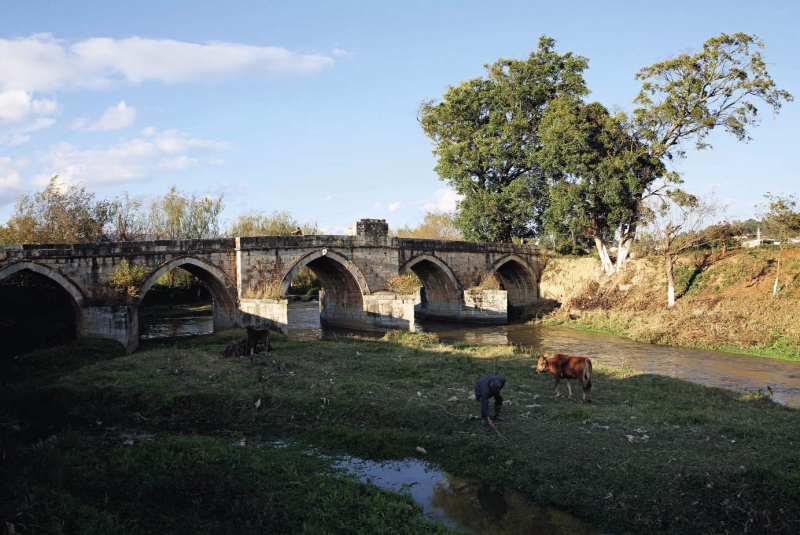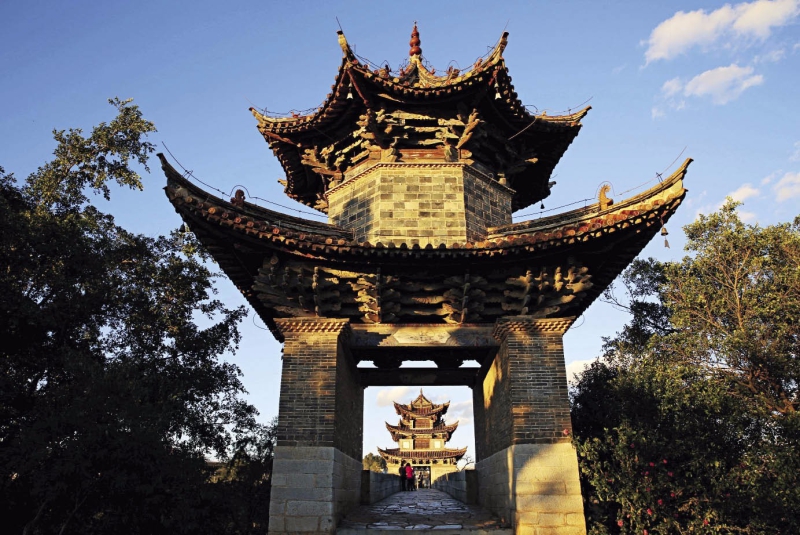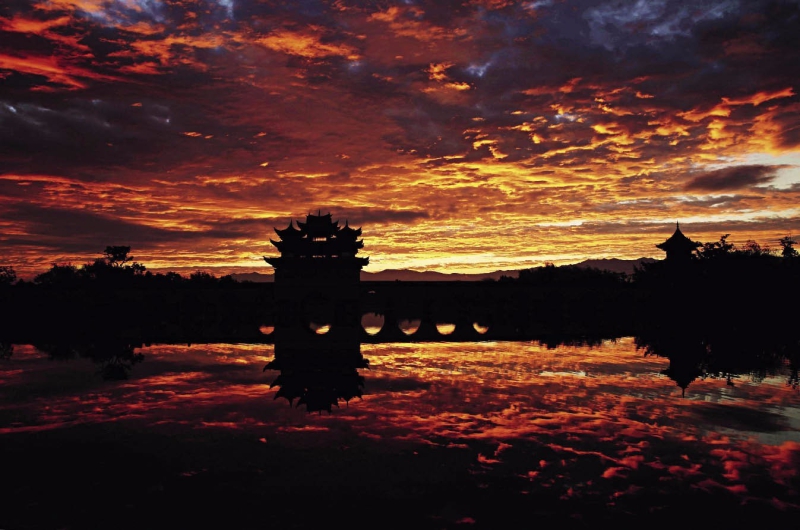The Double Dragon Bridge spans over the confluence of the Lujiang River and the Tachong River, having 17 arches and a pavilion on each end.
Ancient Wells
Jianshui, also known as Lin’an, boasts of glittering water scenery both inside and outside the town. Wells with elaborately-decorated enclosures throughout the town have been providing clean drinking water to local inhabitants for centuries.
The most reputed ancient well is located near the Qingyuan Gate in the west of the town. It was named Daban Well by locals. According to the Annals of Yunnan, the quality of the water found in that well surpassed every other well across the province.
In ancient times, the town usually woke up to the sound of chanting water peddlers. People who lived nearby the well carried buckets of water home hanging them from bamboo poles balanced on their shoulders. Other people who lived far away would buy water from peddlers who sold water from buckets on a cart. The well was especially crowded with people in the morning and evening.
Located across from the Daban Well is a tofu shop whose fragrant aroma which can be smelled far away tells of its local special delicacy. Friendly female workers inside are dexterous at making tofu. Batches of snow-white blocks of tofu like cute elves seem to jump out of the wooden boxes where they are placed. Local residents love grilled tofu. A pan of charcoal, a pair of chopsticks, and a grill rack are all that are needed to make a feast with tofu. Stands packed with foodies can be seen everywhere throughout the town from early in the morning till late at night, making it a unique sight of Lin’an.

The Yongji Bridge with five arches boasts a history of more than 200 years.
Close to the Daban Well is another well called Xiaojie Well, whose water is equal in quality with the Daban Well. But what makes it special is the chilling temperature of the water and the instant resumption of the four-meter deep water level especially amid pouring storms. At the bottom of the water can be seen a harmonious picture of red fish frolicking around bamboo pawns. The platform on which the well stands, as well as the well curb and wall were all made from stone. Adjacent to the well is a residence whose splendor has gradually faded with the passing of time. A senior resident fetching water said the property belonged to a temple, which enshrines the God of Ghosts. Might the chillness of the water have some relation with the worshipped deity? Regardless of what the fact may be, although the water is quite chilly, locals find it safe to drink and many of them have enjoyed a long life drinking it.
Dongjing Well located by the Yinghui Gate in the east of the town was first built during the Yuan Dynasty (1271-1368), and is still brimming with water today. Farmers coming into town to sell vegetables usually stop to take a rest by the well when passing by. They sprinkle some of the water over their vegetables to keep them fresh. When the vegetable is field mint, the fresh smell of the herb floats through the air, unconsciously refreshing passersby with its natural fragrance.
The well with the longest written history is secluded in a remote alley, named Zhuge Well. Strolling across Jianshui Town, visitors will always unexpectedly come across these record-keepers of the old days.

The Tianyuan Bridge built during the reign of Emperor Yongzheng in the Qing Dynasty.
Ancient Bridges
The ancient wells nurture life in Jianshui. If they were the heart of the town, then the waterways flowing in and out of the town would be its blood vessels. And where there is much water, bridges can always be found.
Spanning over the confluence of the Lujiang River and the Tachong River is a bridge named Double Dragon Bridge, as the two rivers look like two coiled dragons. The bridge has 17 arches and a pavilion on each end. The entire structure looks like a rainbow stretching over the rivers. Basking in the dazzling beauty of the dim lights of dawn or dusk, visitors feel like they are watching heavenly revelry as they lean back against the railing and listen to the sound of wind chimes dangling from cornices of the pavilions. The reflection of glimmering roseate clouds that become visible after the sun rises glides along the river surface, turning the bridge arches into gates that lead into a mysterious world.
An S-shape bridge over the Lujiang River 10 kilometers to the east side of the Jianshui Town was dubbed “the bridge of celestial beings” as it was said that footprints of celestial beings were once found there. According to local tales, 100 skillful craftsmen took part in its construction, but only 99 of them attended meals. After the bridge was completed, they found a set of footprints that were different from mortals’ and realized that they had been helped by a celestial being.
An elaborately carved stone shrine was built inside the pavilion of the bridge. There used to be a statue of Buddha and a big bell in the shrine, but sadly only the cleek which hung the bell is what remains today. Under the cleek is a peculiar stone that has become the object of worship for many people. More than 300 years have passed, and the bridge still stands as sturdy as ever. South of the bridge there are seven stellai that record its construction. Surprisingly, there are inscriptions on the rocks about environmental protection, showing that people of that time had an awareness of safeguarding nature.
Lotus Fields
At dusk, an elderly farmer can be seen carrying a pole on his shoulder driving a buffalo down a muddy path. This scene is a typical part of the daily idyllic life of the Jianshui people. Local people mainly farm in lotus ponds. One kind of vegetable they grow is called arrowhead, a vegetable widely seen in the region south of the Yangtze River. Local special grass shoots are also planted in the ponds. The plant has become a symbol of Jianshui. Local people usually eat it in fried and stewed dishes, or add it to salads. Due to the fact they easily spoil after being harvested, they must be cooked the day they are picked.
Lotus is often used in Chinese literature to symbolize integrity and elegance. To local people, it is a cash crop. Its petals, seed pots, seeds, leaves, and roots are all edible. In addition to feeding and enriching the livelihood of local people, the patches of lotus plants in Jianshui present a feast to the eyes.
Just shy of a month after lotus seeds are planted, their leaves are already sprawling over the water, turning the water field into one vast expanse of greenery.
An ancient Chinese ballad depicts the life of lotus farmers in Jianshui. Day after day, they begin their work day at dawn and return home at sunset. They dig wells when they need water and feed themselves by farming. Life here is so beautiful, that no nobody would trade it for even the supreme power of an emperor.






